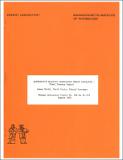| dc.contributor.author | Gruhl, Jim | en_US |
| dc.contributor.author | Coate, David | en_US |
| dc.contributor.author | Schweppe, Edmund | en_US |
| dc.contributor.other | Northeast Utilities Service Corporation. | en_US |
| dc.date.accessioned | 2011-01-11T05:41:10Z | |
| dc.date.available | 2011-01-11T05:41:10Z | |
| dc.date.issued | 1981 | en_US |
| dc.identifier.uri | http://hdl.handle.net/1721.1/60486 | |
| dc.description.abstract | This report is a short summary of three related research tasks that were conducted during the project "Alternative Electric Generation Impact Simulator." The first of these tasks combines several different types of investigations aimed at exploring the potential for, and significance of, uncertainty in the energy technology assessment process. A survey and discussion is presented of technology assessments, primarily from a methodological viewpoint. A general ideal methodology is developed and the potentials for incorporating uncertainties are described. There is particular emphasis on the impacts of assumptions and potential methods for incorporating concepts of uncertainty. | en_US |
| dc.description.abstract | The implementation of an ideal assessment methodology resulted in the second task involving the coding of a simulator that should be viewed as a framework for assembling and manipulating information about the economics, emissions, ambient concentrations, and potential health impacts of different types and configurations of electric power generating facilities. The framework is probabilistic, and thus results in several measures of the range of various consequences, in other words a graphic display of the quality of the various predictions. The simulator is structured so that it is easy to improve the sophistication of certain manipulations, or to replace generic data, or update or add new data. The latest version of the simulator is available from the authors and can be operated in batch or interactive modes. | en_US |
| dc.description.abstract | The third task involved the prediction of the ambient air quality standards over the next thirty years. This was required in order to have benchmarks against which to compare the performance of facilities which are simulated in the task 2 simulator. This third task required the development of a standards prediction methodology through a modified Delphi-style survey of a large set of consultants. | en_US |
| dc.description.abstract | In the face of a neverending battle to gather current data and update the computer codes, the material described in this report is of general interest. The annotated computer codes are available separately. | en_US |
| dc.format.extent | 120 p | en_US |
| dc.publisher | Cambridge, Mass. : Massachusetts Institute of Technology, Energy Laboratory, 1981 | en_US |
| dc.relation.ispartofseries | Energy Laboratory report (Massachusetts Institute of Technology. Energy Laboratory) no. MIT-EL 81-044. | en_US |
| dc.subject | Electric power-plants | en_US |
| dc.subject | Energy policy | en_US |
| dc.title | Alternative electric generation impact simulator : final summary report | en_US |
| dc.identifier.oclc | 09555125 | en_US |
